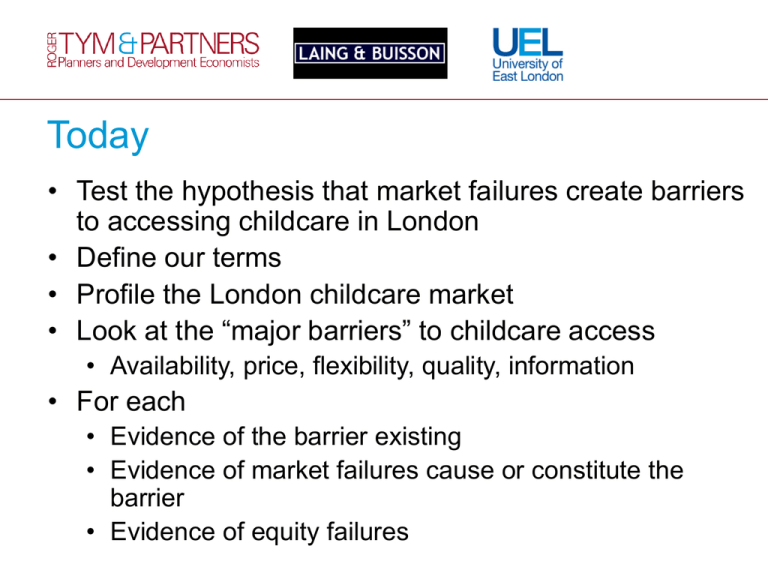Clarke and Lawrence and Blackburn presentation LDA childcare
advertisement

Today • Test the hypothesis that market failures create barriers to accessing childcare in London • Define our terms • Profile the London childcare market • Look at the “major barriers” to childcare access • Availability, price, flexibility, quality, information • For each • Evidence of the barrier existing • Evidence of market failures cause or constitute the barrier • Evidence of equity failures Market failures • Market failures – when markets can’t allocate resources efficiently • Market failures are not when they’re doing “nasty” things • Golden rule 1 : Government can intervene to fix failing markets • Eg - insufficient competition, lack of information to make a decision, when customers can’t be effectively charged • Golden rule 2 : Government can intervene to achieve equity objectives PROFILE OF THE LONDON CHILDCARE MARKET The size of the London childcare market Rest of England 875,100 ‘nondomestic’ places Rest of England 240,250 childminder places London London 42,200 childminder places Source: Ofsted 152,300 ‘nondomestic’ places The size of the London childcare market £0.6 billion (11%) East £0.5 billion (9.5%) West Midlands South West £0.5 billion (9%) Yorkshire North West £0.5 billion (8.5%) £0.7 billion (13%) East Midlands £0.5 billion (8%) North £0.2 billion (3.5%) London £1 billion (18%) South East £1.1 billion (19.5%) Source: Laing and Buisson The childcare market in England has now matured following a period of strong growth % 6 London 5 4 3 2 1 0 England -1 -2 Q2 Q3 Q4 Q1 Q2 Q3 Q4 Q1 Q2 Q3 Q4 Q1 Q2 Q3 Q4 Q1 Q2 Q3 Q4 Q1 Q2 Q3 Q2 Q3 Q4 Q1 Q2 2003 2004 2005 2006 20 07 2008 2009 2010 Childcare places in London have fallen in recession, but not as badly affected as others Impact of Recession in 2009 on Nursery Business Performance, London and UK London UK % 60 50 46.2 40 34.9 34.6 30.6 30 20 10 16.5 3.8 5.5 7.7 8.3 3.8 4.3 3.8 0 Improved Significantly Improved a Bit No Change Source: Laing and Buisson Surv ey of Children’s Nurseries Worsened Significantly Worsened a Bit Don't Know London has proportionately fewer third sector providers, and more public sector than England. Private provision levels are similar Share of Non-Domestic Childcare Places by Sector, mid 2010 100% 90% 19 13 80% 70% 27 34 60% Public Sector 50% Third Sector 40% Private 30% 54 53 London England 20% 10% 0% How do types of provision in London compare to elsewhere? • Childcare groups (operating three or more settings) similar to rest of England • London provides • comparatively high levels of out of school provision • comparatively lower levels of day nurseries, playgroups and pre-schools AVAILABILITY BARRIERS TO CHILDCARE TAKE-UP What is the evidence for availability representing a barrier to childcare access? • London - relatively low early years and under 10s childcare supply density • Apparent shortages also reduced by the fact that London parents have a lower demand for childcare... ...and London - 15% vacancy in full day nurseries, more in out of school clubs and childminders – suggesting little frustrated demand... Average occupancy for full day nurseries, London & UK, 2002-2010 % 100 London 90 80 UK 70 60 50 40 30 20 10 0 Jan 2002 Source: Laing and Buisson Jan 2003 Jan 2004 Jan 2005 Jan 2006 Jan 2007 Jan 2008 Jan 2009 Mar 2010 ...there has been strong growth in available supply – particularly in deprived parts of East London... Source: Laing and Buisson ...although more deprived areas still have relatively low supply density of places. Source: Laing and Buisson Evidence suggests that lower levels of childcare supply are accompanied by lower employment rates... 10 80 9 70 Female Employment Rate % (rhs) 8 60 7 50 6 Female Unemployment Rate % (lhs) 5 40 4 30 3 20 2 10 1 0 0 South East South West East East Midlands North West West Yorkshire North East London Midlands & Humber Source: APS ...and in London, higher levels of childcare provision accompany higher levels of female employment... Female Employment Rates and Childcare Density for London Boroughs Female employment rate 80 70 60 50 40 30 20 10 0 0 20 40 60 80 100 Childcare provision density index 120 140 Source: APS, Laing & Buisson ...and growth in levels of childcare provision accompany increases in levels of female employment... Growth in Childcare Provision and Change in Female Employment Rates by London Boroughs 15 10 2009 Female employment rate growth 2004- 20 5 0 0 20 40 60 80 100 120 140 -5 -10 -15 Growth in childcare provision Mar 2003 – Aug 2008 Source: APS, Laing & Buisson ...but this doesn’t prove any relationship between increased childcare supply and increased female employment • “Commonsense” assumption often made: • Barriers to childcare reduce female employment • More childcare causes more female employment • So if we want higher incomes, less child poverty, we need more childcare • But this not proven • Instead, low level of (female) employment might cause low demand for childcare • In a market system, that would cause low supply • We don’t have the answer Summary: the London availability barrier • Does an availability barrier exist? • Potentially – though perhaps not to the extent imagined • So is this market failure? • No. Availability ‘issues’ in London are a market outcome • Is this an equity failure? • Potentially. Availability is uneven (but so is demand) PRICE BARRIERS TO CHILDCARE TAKE-UP Internationally, higher use of full-time formal childcare is related to higher subsidy or public spending Proportion of children under 3 years enrolled in formal childcare, 2006 Czech Republic Malta Austria Slovak Republic Mexico Poland Germany Hungary Lithuania Australia Greece Ireland Estonia New Zealand Canada Latvia Italy Netherlands Spain Slovenia United States Cyprus Belgium France United Kingdom Source: OECD Sweden Norway Luxembourg Portugal Iceland Denmark 80 75 70 65 60 55 50 45 40 35 30 25 20 15 10 5 0 Finland Full-Time Equivalent Using Formal Childcare Percentage Using Formal Childcare % Childcare fees in London are significantly higher than the national average. They also vary significantly within London Regional and London childcare fees per hour Progress has been made on childcare costs, and most parents do not report difficulties paying for childcare Difficulty in paying for childcare (England) Source: National Centre for Social Research Higher staff costs and accommodation costs – and no offsetting rise in local authority free entitlement payments explain the price differential between London childcare and childcare elsewhere in the country Accommodation cost differentials (England and Wales and London) Source: Valuation Office Agency, RTP London prices • So is price a barrier? • For most people, no. For fewer - yes • But there could be specific London issues (more soon) • Is price caused by a market failure? • No. High London prices are a market outcome • So do London prices represent an equity failure? • Potentially... Are high prices in London a barrier? Evidence of market failure? • Structural distortions? – No. Highly fragmented like rest of England, low barriers to entry and competition. No price distortions from monopolies. No abnormal profit margins. In actual fact, margins in London market are probably tighter. • Market pricing works effectively in London. Price differentials reflect wage rate differentials, and property/rent values. Inter-regional price/wage relationship also strong. London childcare pay rates in line with similar sectors. • Main oddity is local authority funding. Doesn’t reflect higher cost of production for childcare providers. At the moment is likely to be the strongest barrier to entry. • High London prices are a market outcome. Affordability is another question • • • • • • • • • Not asking the question whether childcare is expensive, but is affordability likely to be more prevalent in London. International statistics confirm that childcare in UK is relatively expensive. Qualitative research confirms that childcare is too expensive for approaching a quarter of people, though no London figures available. Higher wages in London, however, compensate for higher prices. Fuller picture is revealed, however, when comparing average net incomes. London vulnerable to equity failure because of a wide distribution of prosperity. However, effective tax credit and benefit system should compensate. Does it? Probably not, but why not? Tax credit and benefit system – end game is complex. International statistics confirm that single parents receive generous tax credits/benefits compared to working couples. Other evidence indicates disincentive for mothers to work part-time. Probably a number of disincentives that are more prevalent in London. Requires further investigation. Potential equity failures: childcare costs are of differing importance depending on parents’ circumstances Difficulty in paying for childcare (England) Source: National Centre for Social Research Does the high price of London childcare provision represent an equity failure? • Working Families Tax Credit - important way of equalising access to childcare for low income families • Tax credit take-up is problematic - mixed picture • Take-up for single parent working families in London is above average • Take-up for working couples in London is acutely low • High childcare costs may act as a barrier to part-time employment in London. Particularly affects mothers • So it looks like equity failures persist • But compared to other countries • UK costs are relatively affordable for single parents, once the effect of the (old) benefit system is taken into account • But UK childcare costs are relatively high for households with two adults working FLEXIBILITY BARRIERS TO CHILDCARE TAKEUP Flexibility • Working atypical hours relatively common • Atypical hours can be childcare solution (shift parenting) • Flexible provision has not increased since 2005 Source: National Centre for Social Research A substantial minority of mothers report that a typical hours cause problems with childcare Whether a typical working hours caused problems with childcare, by family type (England) Source: National Centre for Social Research Flexibility • So does a barrier exist? • Yes, for a substantial minority • Is there a market failure? • No • Profit margins are lower outside core hours • Staff costs go up • Therefore flexibility problems are a market outcome • Is this an equity failure? • Potentially: lone parents’ childcare arrangements are disproportionately affected by atypical working Source: National Centre for Social Research QUALITY BARRIERS TO CHILDCARE TAKE-UP Is quality a barrier? 40% of parents think quality is poor, or are “not sure” (but parents’ perceptions of quality do not necessarily align with those of professionals) Perceptions of quality of local childcare places, 2004-2008 (England) Source: National Centre for Social Research Is a lack of real or perceived quality caused by, or constitute, a market failure? • Some evidence of information market failures cause of perceptions of poor quality • Childcare funding is too low to secure high quality care? • But this does not constitute a market failure • It’s a market outcome Does a lack of quality childcare represent an equity failure? • Evidence that quality of childcare is perceived as worse in more deprived areas • Ethnic minorities do not use childcare services to the same degree as host populations • Prima facie evidence of an equity failure (not proof) INFORMATION BARRIERS TO CHILDCARE TAKE-UP Information issues are often quoted as a barrier • Information has been improved • England parents: 43% say “enough info”; 37% say not • But how much information do you need to make a choice? • Our work suggests that generally, this barrier is being overcome • A lack of information may cause parents to underestimate the long term benefits of childcare • This might represent a “barrier to take-up” Is a lack of information caused by, or constitute, a market failure? Is it an equity failure? • No real evidence of systemic shortage of information that impedes choices • Certain individuals and groups need additional help • This would represent equity failure Summary: the barriers to access: • No substantial market failures in London’s childcare market • Lots of market outcomes • If market-based policies are not achieving the desired objectives, causes may be bad policy, not bad markets • Equity failures exist in the market • Significant attempts have been made to correct these • The causality of the processes involved in creating and maintaining childcare barriers to take-up are open to different interpretations, eg • A lack of available childcare supply might not cause unemployment • Unemployment might cause a lack of childcare demand What are the other barriers to childcare take-up? • Here we looked at the typical barriers identified: availability, price, flexibility, quality • Major progress made on these areas over last decade • Are we into diminishing returns on these areas? • All these barriers could be entirely overcome and still some parents would not take up childcare • So what are the other potential “barrier” areas to work on? • “Children are too young” for formal childcare • Significant cultural barriers to childcare take-up • Content and concept: Lack of demand for childcare must not be confused with lack of demand for Early Years Education Next steps • These are not rational markets • Don’t always respond to “rational” treatments • eg “overcoming barriers” • If we want to increase take-up in London • London-only breaks from NatCen work • Closer look at decision-making processes (perhaps focus groups, behavioural psychology, ethnographic techniques) • Interesting applications of “Nudge”-type concepts • Significant issue in London - relationship between housing costs, income, tax and subsidy • Increased provision of early years education (not “childcare”)








